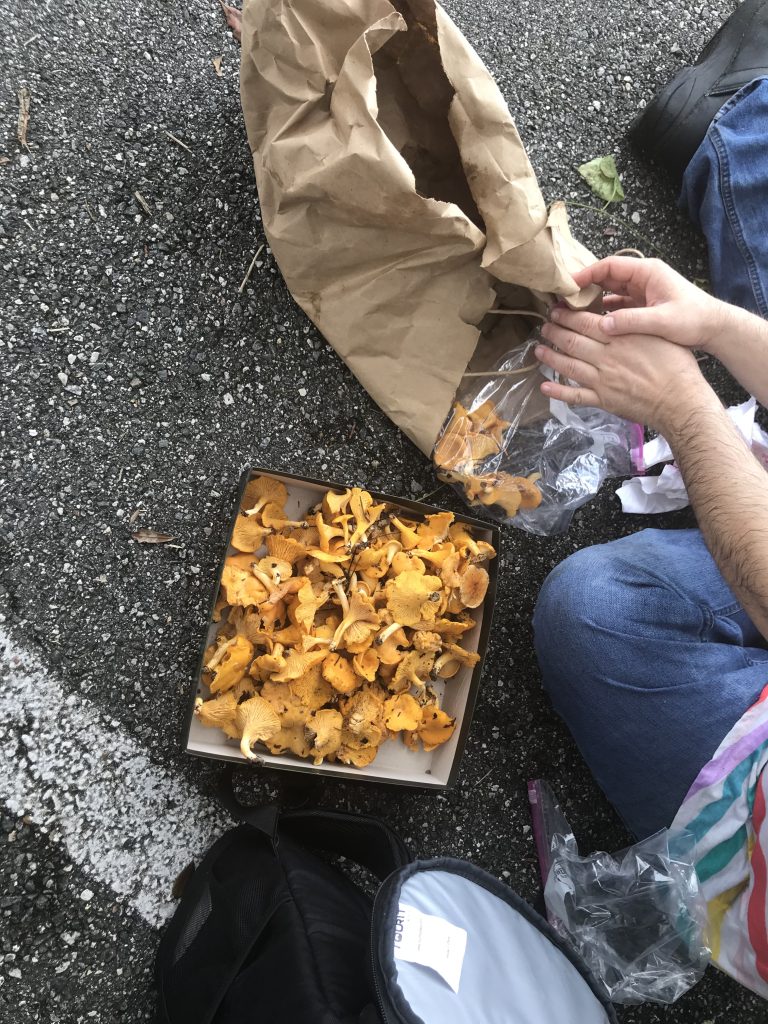
Steven sorting some of the chanterelles picked during a foraging class last Saturday. Photo by Green Deane
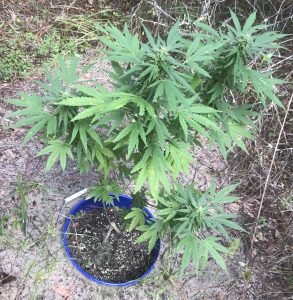
A third of someone’s marijuana crop.
A half-a-year ago while wandering around Ocala we saw a patch of woods that seemed that it might be good for chanterelles. On returning this past weekend, we were right. We could have harvested hundreds of pounds of them. As it was we all went home with as many as we wanted. (A shower interrupted the forage.) We also discovered by accident someone’s marijuana patch, which was left undisturbed. Such discoveries are common among homeless camps and or spoil islands (islands made by dredging and visited by kids.)
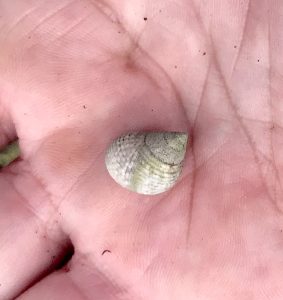
Edible Periwinkles, photo by Green Deane
The next day during a class near Daytona Beach we saw a lot of Goji berries in blossom — they should be ripe by Christmas. Also noticalbe was a huge number of periwinkles Littorina irrorata the Gulf Periwinkle aka the marsh periwinkle. Fortunatly the Southern Herbalist Darryl Patton has written an article on Periwinkles and answered my question, yes, they are edible. The name of this page is Eat The Weeds and Other Things Too, periwinkles are other things. With food shortages a possibility an easy-to-collect seafood is good to know. What I need to know now is does one treat them like land snails, that is, do you feed them a diet of something else a few days before cooking and consuming them. Periwinkles can be boil or roasted, and are found from New England to Central Florida and along the gulf coast. Use like clams.Periwinkles are sensitive to toxic agents so if you find them alive and well the area is probably not toxic.
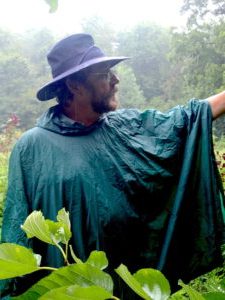
Classes are held rain or shine (but not during hurricanes.)
Foraging classes this time of year have to play dodge ball with hurricanes and tropical storms. We should be fine this weekend.
Saturday September 24th,Blanchard Park, 10501 Jay Blanchard Trail, Orlando, FL 32817. 9 a.m. Meet by the tennis courts.
Sunday September 25th,George LeStrange Preserve, 4911 Ralls Road, Ft. Pierce. 9 a.m.
Saturday October 7 th, Red Bug Slough 5200 S. Beneva Road, Sarasota. 9 a.m.
Sunday October 8th, Boulware Springs Park, 3420 SE 15th St., Gainesville, FL 32641. 9 a.m.
For more information, to pre-pay or to sign up for a class go here.
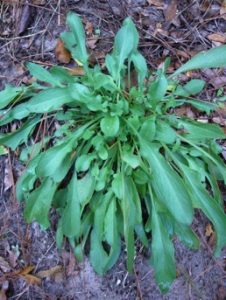
The leaves of Heartwing sorrel resemble a knife hilt. Photo by Green Deane
In some parts of the country fall is upon the landscape and final harvesting is underway before plants shut down for the winter. When I was a boy in Maine this meant scrumping apples and concord grapes. Locally our winter foraging season is just starting and while it is still warm one edible to start looking for is the Heartwing Sorrel. This tart Rumex is closely related to Sheep’s Sorrel — sometimes is called that — and is used the same way, usually as an addition to salads. This time of year there will be a plant here and a plant there. Look along grassy trails, pastures or fields particularly in northern areas. In a few months locally it can cover an entire field with a ruddy pink blanket of ripening seeds. To read more about the Heartwing Sorrel go here.
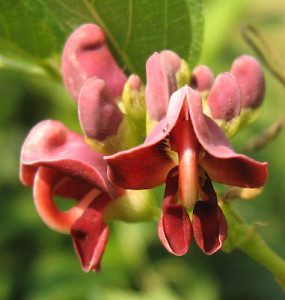
Ground Nut blossoms look pretty but smell bad.
Blossoming now and making it easy to spot are Ground Nuts, or Apios americana. This is a vine found in wet spots nearly everywhere east of the Rockies. It has clusters of maroon pea blossoms, which means “wings and keels.” The four petals of pea blossoms arrange themselves differently than most blossoms. Two flare out and two form together creating what looks like a boat’s keel and two wings. Grounds Nuts are a foraging staple and were also the second plant product exported from the New World to the Old World. The first was Sassafras wood. While we find Ground Nuts in damp spots they will happily grow in a regular garden producing edible tubers for many years. More to the point, once you know what the underground tubers look like you can easily identify them anywhere you find them. To learn more about Ground Nuts go here.

Carl had a dirty mind.
Plant Pronunciations: What’s really important is knowing the plant and whether you can eat it or not. What you call it is secondary. Common names are okay as long as you know many plants can have the same common name. “Indian Potato” comes to mind. There are two problems with common names. You and someone else could be talking about the “Indian Potato” but actually be talking about two different species. Also every plant — in theory — has one botanical name but can have virtually dozens of common names. Many times it is just easier to remember the one botanical name. Dead Latin was chosen for the naming plants because it’s dead, non-changing, non-evolving and not the mother tongue of any nataive population. Perhaps it was also chosen by academics as a way to keep Latin from disappearing completely. Another possibility was they wanted to use naughty descriptions and if in Latin most wouldn’t know how lewd some botanical names are. Know even when Latin was spoken it had regional accents and far flung Latin became French, Spanish and Romanian. At home it became Italian. There is no etched-in-granite correct way to pronounce botanical names. Hmmmm…. take Vagus. It can be said like the city, Los Vegas, or vah-GOOSE. It means literally “wandering.” And of course there are different pronunciations of botanical names in American English vs British English such as with the pine genus (PINE-us, vs. PEEN-iss.)
Many “Latin” plant names are mangled Greek. Take the genus Dioscorea, the true yams. Dead Latin has it dye-oh-SCORE-ree-ah. That makes my ears hurt. It’s named after a Greek physician, Dioscorides, 40-90 AD. So I prefer thee-oh-score-REE-dez which closer to the Greek way of saying it. The only time the botanical name is truly important is to make sure the two of you are discussing the same plant. This happened recently when I received an email from Singapore about how to use the Skunk Vine. There are several Skunk Vines (like Indian Potatoes, Hog Plums et cetera.) As we were exchanging information about Paederia foetida without the botanical name that would have been difficult. Scientific names of any species can be a personal hurdle. And some times you don’t have a choice. The majority of mushrooms do not have a common names. You just have to bite the Boletus.
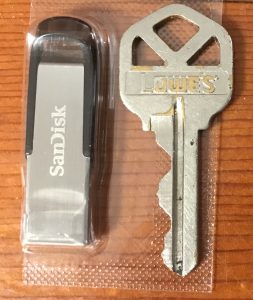
You get the USB, not the key.
Changing foraging videos: As my WordPress pages are being updated the video set will go away. They are the same videos I have on You Tube. Some people like to have a separate copy. The DVD format, however, is becoming outdated. Those 135 videos plus 36 more are now available on a USB drive. While the videos were played from the DVDs the videos on the USB have to be copied to your computer to play. They are MP4 files. The 171-video USB is $99. If you make a $99 “donation” using the link at the bottom of this page or here, that order form provides me with your address, the amount — $99 — tells me it is not a donation and is for the USB.

Green Deane Forum
Want to identify a plant? Perhaps you’re looking for a foraging reference? You might have a UFO, an Unidentified Flowering Object, you want identified. On the Green Deane Forum we — including Green Deane and others from around the world — chat about foraging all year. And it’s not just about warm-weather plants or just North American flora. Many nations share common weeds so there’s a lot to talk. There’s also more than weeds. The reference section has information for foraging around the world. There are also articles on food preservation, and forgotten skills from making bows to fermenting food.
This is weekly newsletter #524. If you want to subscribe to this free newsletter you can find the sign-up form in the menu at the top of the page.
To donate to the Green Deane Newsletter click here.



When I lived in CT many years ago we used to go to the shore and get a free feast! Periwinkles were the kid’s favorite, but they were often gritty, so we would add cornmeal to the bucket of seawater and let them sit overnight. It helped.
I want to learn foraging..NE Texas